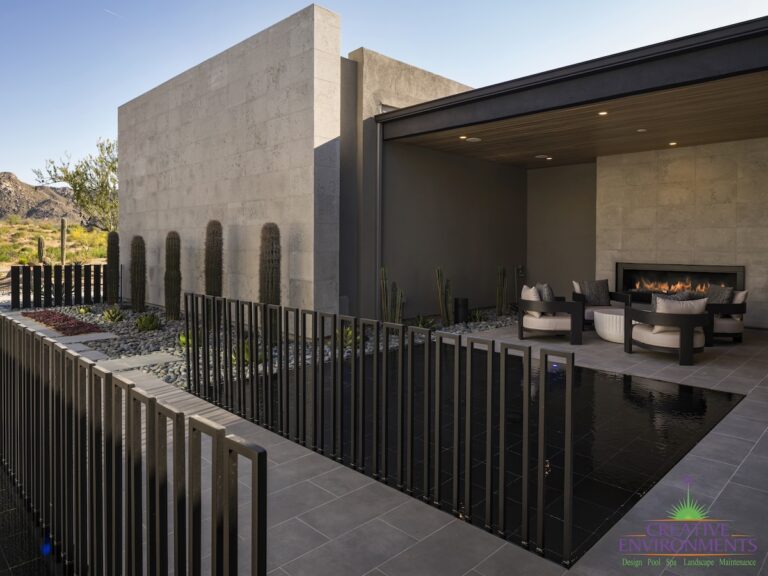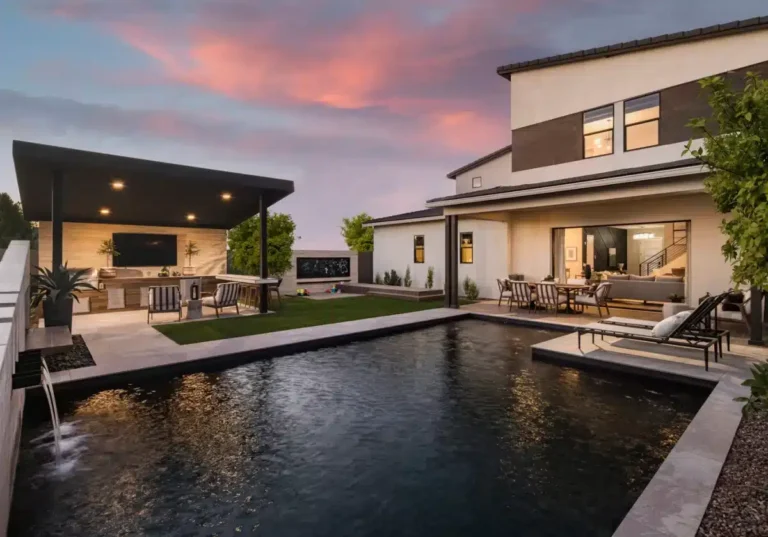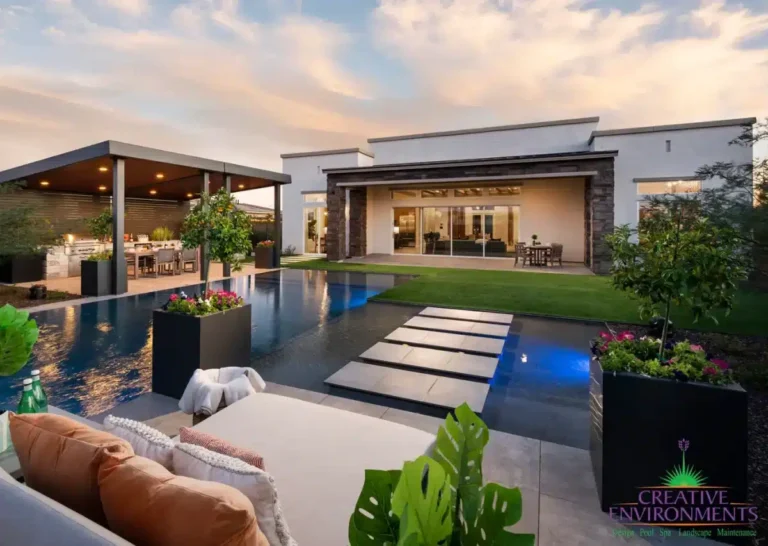When it comes to creating a lush, green lawn for your luxury landscape, the decision between artificial turf and real grass is pivotal. Each option has its own set of advantages and drawbacks, and understanding these can help you make the best choice for your property. Here, we explore the pros and cons of both artificial turf and real grass to help guide your decision in your landscape design.
Artificial Turf
We utilized artificial turf at The Shadowridge to create crisp, clean lines between the pool decking, stepping stones and annuals perimeter. View the full gallery here.

Pros for Using Artificial Turf in Your Landscape Design:
Low Maintenance
Artificial turf requires minimal upkeep. There’s no need for mowing, watering, fertilizing, or pest control, which can save both time and money.
Water Conservation
In arid climates like Arizona, water conservation is crucial. Artificial turf doesn’t require watering, making it an environmentally friendly option.
Durability
High-quality artificial turf can withstand heavy foot traffic and harsh weather conditions without becoming patchy or worn out.
Consistent Aesthetic
Artificial turf maintains its vibrant green color year-round, regardless of weather conditions, ensuring your landscape design looks pristine at all times. It also makes it easy to plan for intricate designs, knowing that the space will not need constant maintenance for features such as stepping stones, artificial turf patterns and more.
Allergy-Friendly
For those with grass allergies, artificial turf can be a great alternative, as it doesn’t produce pollen.
Cons for Using Artificial Turf in Your Landscape Design:
Initial Cost
The upfront cost of installing artificial turf can be higher than planting natural grass. However, the long-term savings on maintenance can offset this initial investment.
Heat Retention
Artificial turf can become quite hot in direct sunlight, potentially making it uncomfortable for bare feet and pets during the summer months.
Environmental Impact
While artificial turf saves water, it’s made from synthetic materials that are not biodegradable. Additionally, the production process can have a significant carbon footprint.
Surface Feel
Some people find the texture of artificial turf less comfortable and less natural compared to real grass.
Replacement
Artificial turf has a lifespan of about 10-20 years, after which it will need to be replaced, adding to long-term costs and environmental impact.
Real Grass
At The Avenida Del Sol, we utilized real grass in the front yard landscape creating a modern walkway to the front door.

Pros for Using Real Grass In Your Landscape Design:
Natural Aesthetic
There’s no substitute for the look and feel of natural grass. It provides a soft, cool surface underfoot and a pleasing natural scent.
Environmental Benefits
Real grass contributes to the environment by absorbing carbon dioxide, producing oxygen, and providing a habitat for wildlife.
Cooling Effect
Natural grass has a cooling effect on its surroundings, reducing the heat island effect in urban areas and keeping your landscape cooler.
Biodiversity
A real grass lawn supports a diverse ecosystem, attracting insects, birds, and other wildlife, which can enhance the natural beauty of your garden.
Economic Value
A well-maintained real grass lawn can increase the property value and appeal of your home.
Cons for Using Real Grass In Your Landscape Design
High Maintenance
Natural grass requires regular mowing, watering, fertilizing, and pest control, which can be time-consuming and costly.
Water Usage
Maintaining a lush, green lawn in dry climates can demand significant water resources, which may not be sustainable in areas with water restrictions.
Seasonal Variability
Real grass can go dormant or turn brown in extreme weather conditions, leading to an inconsistent appearance throughout the year.
Pest and Disease
Natural grass is susceptible to pests and diseases, which can cause damage and require chemical treatments.
Wear and Tear
High foot traffic and pet activity can cause wear and tear on natural grass, leading to bare patches and uneven surfaces.
All in all, when deciding between artificial turf and real grass, consider your priorities and the specific conditions of your landscape design. If you value low maintenance and consistent appearance, artificial turf may be the ideal choice. However, if you cherish the natural beauty and environmental benefits of a real grass lawn, and are willing to invest the time and resources into its upkeep, natural grass could be the better option.
At Creative Environments, we are dedicated to helping you create the perfect outdoor space that meets your aesthetic and functional needs. Our expert team can guide you through the decision-making process, ensuring you choose the best option for your luxury landscape design. Contact us today to learn more about our services and how we can help transform your modern Arizona backyard!



